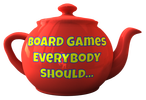Crows Overkill (2014) reviewThe game Crows Overkill is inspired by an old Japanese song. "Sanzen-sekai no karasu wo koroshi, nushi to asane gam shitemitai". It means: "I'd kill all the crows in the world to sleep with you in the morning". These words are said to have been uttered by Takasugi Shinsaku, a central figure of the early Meiji Restoration. This man loved passionately to frequent the red-light district. This song is like a declaration of love. He assumes that when a raven caws, he must leave his geisha. So, he wants to kill all the crows in the world to enjoy a moment of privacy. Taking up the idea of this old popular song, the designer Roy Nambu (Kaichin) created the game Sanzen Sekai: I'd kill all the crows in the world to be with you a little longer. We agree it's too long a title. In the latest edition, the name was changed to Crows Overkill when published by EmperorS4 (Round House, Planet Defenders) in 2017. Playable from 2 to 4, each player role-plays a guest who has comes to enjoy the charms of a house located in the red-light district. Unfortunately, very quickly, many birds come to try to break the magic of the moment by singing under the windows. The goal of each guest will be to enjoy moments of happiness as long as possible. The player who will stay the longest will win the game. So, you will have to fight not only against noisy crows, but also warblers, roosters, bats and owl. A real barn! This menagerie of feathered fiends will come to gather as you play and time passes around your windows. The slightest cry, and “bingo” you have to leave the place. To leave means elimination from the game. You will have to do your best to silence these birds of misfortune. To help you, you will have equipment represented by shamisen cards to help you stay. The game consists of two types of cards: birds and shamisen. Upon installation, you start with three bird cards in front of you and two shamisen in your hand. At the beginning of your turn, you’ll draw three new birds cards and two extra shamisen cards. This step will come back to you every turn. The birds, like in the Hitchcock film, will keep coming back. Once this is done, you will do your best to stay in the game and arms of your love. Depending on the time of day, it will be more and more difficult to prevent a type of bird from screaming. The closer we get to the morning, the less chance there is to stay in play. So you are free to play as many Shamisen cards as you want to protect yourself at best. The abilities of the cards are indicated on them. You can also sacrifice a card without applying its effect to simply kill a bird (and those of you with the RSPB will probably want to look away at this stage). When you think you're ready, skip to the end of the turn. Then, check if you have respect the conditions to prevent the birds from singing you out. If so, play moves on to the next player. Otherwise, you must leave the building, which means your elimination. The change of hours is done using special cards, the bells that are hidden in the birds deck of cards. The longer the time, the more difficult it will be to stay in play. I’ll just tell you right now, Crows Overkill is a game that will not please everyone. It's a pure game of luck and "take that." Here, there is no real strategy, just pure opportunism. From one turn to another, everything can radically changed. Thanks in particular to the magnificent illustrations of Amayagi-do (Hyakke-Yagyo), the game exudes a certain charm. The traditional choice of illustrations works perfectly. The immersion is only greater in this struggle of every moment, facing the injustice of the arrival of the birds at your side rather than at the other around the table. The game offers very simple rules, making is easily assimilated. The ubiquitous luck can frustrate more than one player, not to mention the final elimination of a player in the game. Fortunately, the duration of the game is very short. It takes about fifteen minutes, if all goes well. I say fortunately, because even if you are unjustly eliminated, you will not have wait long to replay (or set up another game). The "take that" is (maybe too) important to the game. We sometimes even feel like using and abusing this power. But hey, we're not here to make friends. If you do not like being persecuted or another player infringes on your freedom of action, it is better to play something else. No alliance, no friends, no mercy. We must do everything to save ourselves, even if we send everything to the other players. After all, our happiness comes before the neighbor's, doesn’t it? The theme is very well exploited. The quirky side is well transcribed by the graphics and mechanisms. Mechanisms that are simple but effective and in adequacy with the transcribed universe. So we find ourselves praying for these cursed devils to fly to another window, other than our own. If you are looking for a little party game, nasty, cunning and ruthless then, Crows Overkill may be right for you. The more players there are, the more interesting the game will become. With two players, we are in each others face, where finally only luck will really separate you. A little game with an original theme and a pleasant atmosphere. But a game not necessarily to put in all hands. I have warned you. The happiness of the moment demands sacrifices. Technical Score 7/10
Cards are beautiful and well-made. My BGG Score 7/10 (Good game, usually willing to play.) Easy to play, beautiful, nasty, fun and fast to play. Combined Score 7/10 And now it's over to you ...
0 Comments
On this Saturday, March 9, 2019, your mission, if you accept, will be to go to Epinal to discover the fun festival and come back with game reviews. Confident in our abilities, proud to receive this quest, we set out on a fun adventure. For the first time, I went to the festival Jeux et Cie d'Epinal, in France. Fortunately, to help me and support me in this heavy task, Barry (second time at Epinal) accompanied me and guided me in the pouring rain (as well as play the role of chauffeur). After several hours of driving, we arrived at the site: the Congress Center. Easily found, rather well located when you come from far away and with plenty of available parking spaces, the mission seemed to be starting on a good track. This is a free festival, which offers you the chance to discover new or old games in a good atmosphere and for all tastes. That's what the poster promised us. Once inside the room, we actually find ourselves in a family atmosphere, dare I say zen. The stands were quite spaced out, a lot of tables available, people were smiling, even very welcoming. On site, besides the games we found some service in terms of restoration (although I found the thing a bit expensive), games to bring back (wide choice in the local game stores). As for the types of games, the target audience is still family and children even if, here and there we did find games a little more focused on the expert public. The demonstrators and volunteers present were very good, friendly and quick to explain the rules with joy and good humor. A nice surprise for a festival this size. It is regrettable that some publishers did not make the trip or bring protos to test, while others were just not present. Overall it's really nice. Too bad it is a bit far, (a 3 hour plus car journey) if not with pleasure I would go back (especially in such a charming company). Especially since the festival only lasted for three days! Wow. As for our original mission ... So we tried no less than thirteen games. Here are these titles with a (very) short summary and opinion. Plus we pick out our top 3 gaming experiences of the event. Attention, these opinions are first impressions within the framework of a festival (noise/fighting for a table/rules not explained correctly/fatigue from continuous playing), as always in this type of events. These opinions can change by playing the game in other configurations, like at home or different player counts or after watching a Rodney Smith video =). Res Arcana |
AuthorsBarry Doublet & shortcuts
All
|




























 RSS Feed
RSS Feed

